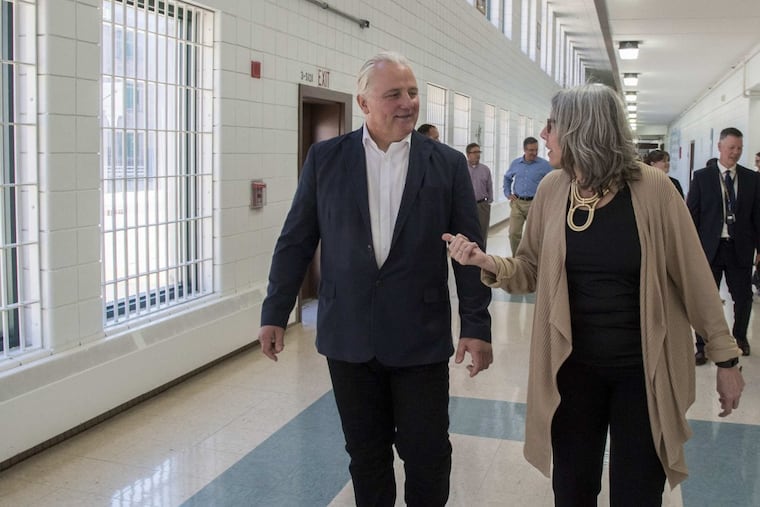From Norway, Pennsylvania's prisons appear cruel and unusual
Norway, a country of 5.2 million, has just 3,900 prisoners; Pennsylvania, a state of 12.8 million, has 48,000, plus thousands more in county jails.

As metal gates swung open and then shut behind him, Are Høidal, the warden of Norway's Halden prison, peered down the long, echoing main corridor of the State Correctional Institution-Chester, a medium-security prison a half-hour outside Philadelphia. Coming from what has been called the world's most humane prison, Høidal said practices here in Pennsylvania can at times seem unaccountably harsh.
"I think you have too much segregation and isolation. That's a big problem in your country: for small things, you're put away for months. In Norway, you'd have maybe eight days in your own cell," he said. "Last year, I met an inmate who had been 40 years in isolation, totally alone. That would never happen in Norway."
Norway, a country of 5.2 million, has just 3,900 prisoners; Pennsylvania, a state of 12.8 million, has 48,000, plus thousands more in county jails. Norway has no restricted housing units; Pennsylvania has more than 2,000 people in segregation. In Norway, there's no such thing as a life sentence; Pennsylvania has more than 5,000 people serving them. In short, the ideological and practical differences between the two correctional systems are vast — yet, thanks to a Drexel University initiative, leaders from each are coming together this week to explore what they can learn from each other.
Jordan Hyatt, a Drexel criminologist who organized the Norwegian delegation's visit to five Pennsylvania prisons this week, said the exchange was meant to provide both technical advice and big-picture perspective. "You tend to see the way you do things as the only way. This is a practical reminder that there are other ways."
Pennsylvania Corrections Secretary John Wetzel, an advocate for reducing the size of the state prison population, had such an awakening during a visit to European prisons a few years back.
"I wish I could afford to bring a bunch of my staff there. Bringing Norway here is the next best thing," he said. "If they gave us the opportunity to reimagine the system, I think it would look a lot more like Norway than like Pennsylvania."
While U.S. justice systems lock people up for long sentences in the name of incapacitation, the principle driving corrections in Norway is rehabilitation. The idea is that inmates are sent to prison as punishment — not to be punished further while incarcerated. Instead, administrators seek to use that time to help the inmate reform. They champion "the normality principle," the idea that life in prison should be significantly similar to being out in the community.
"Every inmate in Norway will be released. Every inmate will come out and be our neighbor," Høidal said. "So, what kind of neighbors do we want?"
In a presentation to Pennsylvania Department of Corrections staff, Høidal said that 30 years ago, Norwegian prisons were a mess, plagued with violence, drugs, escapes, and frequent recidivism.
Lawmakers responded by overhauling the system, and building institutions that look more like high-end gated communities than prisons. They also increased the number of corrections officers drastically, and trained them to act more like social workers than prison guards. They embedded the officers, who are unarmed, with inmates all day long. Recidivism fell from more than 60 percent to somewhere between 14 and 42 percent, depending on how you count it. It's 62 percent here in Pennsylvania.
After the presentation, Wetzel acknowledged the skeptics. "The back of the room always has more arms crossed per capita than the front of the room," he said, looking around. "I hope you can get beyond the notion that it's so different from what we do here that nothing translates."
Still, the reality is this: Halden prison's budget is $125,000 per inmate. That's triple what Pennsylvania spends.
And, Marirosa Lamas, the superintendent at SCI Chester, said there's a broader cultural shift that needs to take place. "There's that need to punish, when in fact incarceration and punishment are two different things."
But Wetzel said there's a lot that could be done with what the Department of Corrections already has, and pointed to reforms the DOC has made, for example, in its treatment of inmates with mental illness.
"You can't make an honest argument that how someone is treated while incarcerated doesn't affect how they behave when they get out."
Høidal came here to learn as well as to teach. He said that what he's seen in Pennsylvania is a far greater focus on rehabilitation than he observed in other states, such as Rhode Island. He was intrigued by the dog-training program he saw at Chester, where inmates socialize newborn puppies and train rescue dogs to prepare them for adoption. "It's genius," he said. Hyatt said he's also been working with Norwegian collaborators to help them adopt rigorous, evidence-based practices and randomized, controlled trials that are already widely used in corrections here.
Still, Hyatt, who's been visiting Norway with students for the last two years, said that back at home he believes a shift has already, however slowly, begun. "As Pennsylvania's system becomes more progressive, it's becoming in some ways more like the Norwegian model."